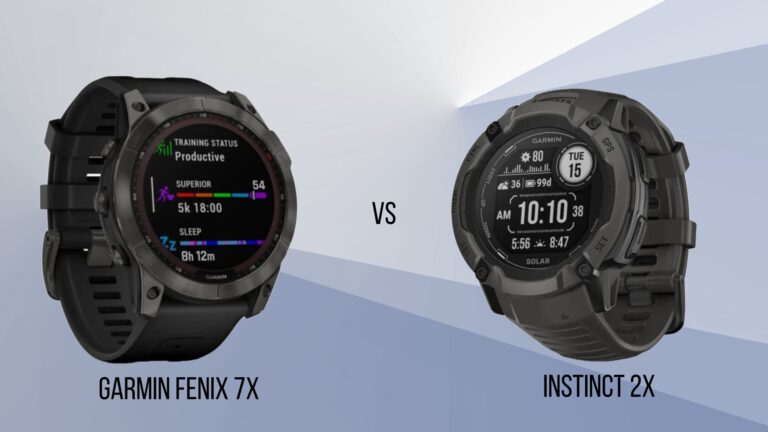Today, I’m going to compare Garmin’s premium sports smartwatches, the Epix Pro and Fenix 7 Pro. These watches come with some fantastic features, such as a built-in flashlight, a new heart rate sensor, new map overlays, and more. There isn’t much of a difference in features between these two.
However, the Epix Pro is $100 more expensive, regardless of the variant you choose. So, should you spend the extra money on it, or should you consider saving and going for the Fenix 7 Pro instead?
I’ve been using both of these watches for the past few weeks, and in this post, I’ll tell you about their similarities and differences, so that you can make your purchase decision based on your requirements.
| Epix Pro | Fenix 7 Pro |
 |  |
| Buy Now | Buy Now |
| Pros | Pros |
| Colorful AMOLED display. Premium look. Bright Flashlight. New Red Shift Mode. 3 size option to choose. | Rugged Design. Multiple Size Available. More Battery Life. Hill and Endurance scores works well. Accurate Heart Rate monitors are a nice plus. |
| Cons | Cons |
| Very Expensive. Decent Battery Life. | Not easy to read in low light condition. Still a pricey Watch. |
Specifications
| Epix Pro (47mm) | Fenix 7 Pro (47mm) | |
| Dimension | 47 x 47 x 14.6 mm | 47 x 47 x 14.5 mm |
| Weight | 70 g | 73 g |
| Build Material | Titanium and fiber-reinforced polymer | Titanium and fiber-reinforced polymer |
| Display | AMOLED with 416 x 416 pixels resolution | Transflective memory-in-pixel (MIP) with 260 x 260 pixels resolution |
| Water Rating | 10 ATM | 10 ATM |
| LED Flashlight | Yes | Yes |
| Storage | 32GB | 32GB |
| Input | Five face buttons and Touchscreen | Five face buttons and Touchscreen |
Design

First, let’s talk about the design. Both smartwatches have a very similar sporty look, which gives them a rugged appearance and feel. I have the 47mm Titanium model for both of them, and their weight is around 70 grams, which is standard for watches of these sizes.
These watches also come in Stainless steel variants, which are more affordable, and they offer size options in addition to the 47mm, including 42mm and 51mm, allowing you to choose a watch that suits your wrist size.
Both of them have a traditional 5-button configuration, with 3 on the left and 2 on the right. The buttons on the left are typically used for up and down navigation, while the buttons on the right handle functions such as lap, stop, start, and back.
Talking about the strap quality, both smartwatches come with comfortable 22mm replaceable straps that you can wear all day without any discomfort.
They both have a water resistance rating of 10 ATM, meaning you can confidently wear them underwater and swim up to 100 meters without any worries. If you’re a professional swimmer, both of these watches are excellent options for you.
Among them, the Epix Pro has a screen with a Sapphire lens, while the Fenix 7 Pro features a Solar Sapphire lens, both of which offer excellent protection to the screen.
In both of them, the Epix Pro features a screen with a Sapphire lens, and the Fenix 7 Pro has a Solar Sapphire lens, both of which provide excellent protection to the screen.
Furthermore, if you opt for the Stainless-Steel models of the Epix Pro or Fenix 7 Pro, they also offer the option of Gorilla Glass and Power Glass, which are slightly less durable alternatives.
Display

The Fenix 7 Pro has a MIP (Memory in Pixel) display, while the Epix Pro features an AMOLED display. Both have the same display size options: 1.3 inches for the 47mm model, 1.2 inches for the 42mm model, and 1.4 inches for the 51mm model. If you desire more screen area, you should consider the 51mm size.
However, the Epix Pro offers higher resolution, resulting in better detail on the screen compared to the Fenix 7 Pro.
On the other hand, the outdoor visibility and readability of the Fenix 7 Pro display are outstanding because it automatically increases brightness by receiving light, and it also features solar capability to help extend battery life.
Indeed, the Fenix 7 Pro also has a backlight, which I don’t typically need during the day, but it comes in handy in low-light situations, such as a dark room.
The Epix Pro’s display also offers good outdoor visibility, but you need to increase the brightness for that, which drains the battery. That’s why I find the Fenix 7 Pro a little better for outdoor use. However, I prefer the Epix Pro’s display more for indoor and nighttime use.
Its AMOLED display is very beautiful with vibrant colors, which is why using the Epix Pro feels like using a smartphone, even though both have the same User Interface. If you also appreciate a colorful display, you’ll definitely like this.
Battery Life
Look, I’ve been wearing both the Fenix 7 Pro and Epix Pro for almost 2 weeks, during which I only used them as regular smartwatches, and during this time, I didn’t need to charge either of them.
You get different battery life in various sizes, so I have mentioned the battery life for all their models in the box below, so that if you are considering getting a different size, you can have an idea.
Fenix 7 Pro Battery Life: –
| Finex 7S Pro (42mm) | Finex 7 Pro (47mm) | Finex 7X Pro (51mm) | |
| With Solar | |||
| Smartwatch | 14 DAYS | 22 DAYS | 37 DAYS |
| Battery Saver Watch Mode | 87 DAYS | 173 DAYS | 1 YEAR |
| GPS Only | 46 HRS | 73 HRS | 122 HRS |
| All Satellite Systems | 30 HRS | 48 HRS | 77 HRS |
| All Satellite Systems+ multi-band | 16 HRS | 26 HRS | 41 HRS |
| All Satellite Systems + Music | 7 HRS | 10 HRS | 16 HRS |
| Max Battery GPS | 162 HRS | 289 HRS | 578 HRS |
| Expedition GPS | 43 DAYS | 74 DAYS | 139 DAYS |
Epix Pro Battery Life: –
| (42mm) | (47mm) | (51mm) | |
| Without Always ON Display / With Always ON Display | |||
| Smartwatch | 10 DAYS / 4 DAYS | 16 DAYS / 6 DAYS | 31 DAYS / 11 DAYS |
| Battery Saver Watch Mode | 14 DAYS | 21 DAYS | 41 DAYS |
| GPS Only | 28 HRS / 20 HRS | 42 HRS / 30 HRS | 82 HRS / 58 HRS |
| All Satellite Systems | 21 HRS / 16 HRS | 32 HRS / 24 HRS | 62 HRS / 48 HRS |
| All Satellite Systems+ multi-band | 13 HRS / 10 HRS | 20 HRS / 15 HRS | 38 HRS / 30 HRS |
| All Satellite Systems + Music | 6 HRS | 10 HRS | 17 HRS |
| Max Battery GPS | 49 HRS | 75 HRS | 145 HRS |
| Expedition GPS | 9 DAYS | 14 DAYS | 27 DAYS |
The Fenix 7 Pro doesn’t have any significant differences from the Epix Pro when the solar ability is not enabled. However, when you activate it, there is a noticeable difference that greatly extends the battery life.
Even though the Epix Pro lags behind in this regard, it still offers a fairly decent battery backup, particularly due to its AMOLED display. if you want better battery life with an AMOLED display, you can consider the larger model of the Epix Pro.
Smart Features

The Smartwatch features in the Epix Pro and Fenix 7 Pro are exactly the same, such as receiving phone notifications, handling calls (rejecting and receiving), calendar, weather forecasts, Morning report, and making contactless payments with Garmin Pay.
Like other Garmin smartwatches, both of them also support Amazon Music, Deezer, and Spotify. You can easily connect your headphones to the watch via Bluetooth and listen to music. Furthermore, both models come with 32 GB of internal storage, which can be used for offline music downloads.
Both of them have highly accurate satellite sensors that can easily track you even in extreme environments.
The built-in flashlight feature in these watches is quite impressive. Both flashlights are bright, and they offer various adjustment options like brightness levels, red light, strobe, and distress light settings. These features come in handy not just for signaling with the flashlight at night but also in other situations.
Epix Pro also introduces a new feature called “Red Shift Mode.” This feature is particularly useful at night when you check the time on your watch while going to sleep.
It changes the entire watch interface to a red shade, which helps prevent straining your eyes from the blue light of the AMOLED display and disrupting your sleep cycle.
Now, let me tell you about the new feature called “Up Ahead” in the Epix Pro and Fenix 7 Pro. If you’ve used Phoenix 7 and Epix Gen 2 before, you might recall “Up Ahead,” which was used to track waypoints like aid stations in pre-designed courses.
Garmin has taken this feature to a new level. When you are on a course with waypoints, you’ll see icons for these waypoints on the map view. This is quite useful for races and larger activities.
Health & Fitness Tracking

Both of them feature new heart rate sensors that accurately measure heart rates. Additionally, they offer advanced training metrics and recovery insights, which include Training Status, Training Readiness, VO2 Max (Run and Trail Run), Training Load, Real-time Stamina, visual race predictor, and recovery time, among many other features.
These features are highly beneficial for individuals who want to track their training and take their performance to the next level.
Apart from all these features, both watches have added two High-tech training metrics: Endurance Score and Hill Score, which further assist in tracking your training.
Starting with the Endurance Score, it not only estimates your VO2 max but also evaluates how your overall training is improving your endurance. The higher your score, the better your endurance.
As for Hill Score, it is a running metric that calculates uphill running capacity based on fitness, performance data, and VO2 max. It operates on a scale from 0 to 100. Similar to the Endurance Score, a higher score indicates better uphill capacity.
The Hill Score also provides detailed information, such as Hill Endurance, Hill Strength, and Estimated VO2 max.
Believe me, both of these watches are fantastic for tracking your progress and enhancing your training, especially if you are training for activities like ultra marathons or mountain running.
Activity Profiles
In both of these Pro models, Garmin has added some new profiles alongside the existing activity profiles, especially for team sports. There is no difference in this aspect, so I’ve listed all the available activity profiles in both below.
| GYM ACTIVITY PROFILES | Strength, HIIT, Cardio and Elliptical Training, Stair Stepping, Floor Climbing, Indoor Rowing, Boxing, Mixed Martial Arts, Pilates, Yoga |
| RUNNING PROFILES | Running, Outdoor Track Running, Treadmill Running, Indoor Track Running, Trail Running, Virtual Running, Ultra Running |
| OUTDOOR RECREATION PROFILES | Hiking, Indoor Climbing, Bouldering, Climbing, Mountain Biking, Skiing, Snowboarding, Backcountry Snowboarding, XC Classic Skiing, Backcountry Skiing, Water Skiing, Stand Up Paddleboarding, Rowing, Kayaking, Surfing, Wakeboarding, Wakesurfing, Tubing, Hunting, Kiteboarding, Windsurfing, Snowshoeing, Fishing, Horseback Riding, Motorcycling, Overlanding, Motocrossing, ATVing, Snowmobile, Ice Skating, Boating, Sailing, Sail Racing, Jumpmaster, Tennis, Pickleball, Padel, Badminton, Squash, Table Tennis, Archery, Whitewater, Tactical, Disc Golf, Sailing Expedition |
| SPORT PROFILES | American Football, Field Hockey, Ice Hockey, Soccer/Football, Lacrosse, Rugby, Ultimate Disc, Cricket, Softball, Baseball, Basketball, Volleyball |
| CYCLING PROFILES | Biking, Road Biking, Mountain Biking, Gravel Biking, Bike Commuting, Bike Touring, eBiking, eMountain Biking, Indoor Biking, Cyclocross, Triathlon, BMX |
| SWIM PROFILES | Pool Swimming, Open Water Swimming |
Weather Map Overlays

Weather Map Overlays are also a new feature available in both of these watches. This feature provides information on precipitation, cloud cover, temperature, and wind speed on the map view. Pretty amazing, right?
However, here’s a twist: you can only access this feature within the Weather Widget, not in between your activities. Furthermore, you need cellular connectivity to sync the Weather map; otherwise, the map won’t update.
Out of the two, the Epix Pro’s map appears a bit more natural due to its AMOLED display. However, because of the higher resolution, it redraws the map a bit slower compared to the Fenix 7 Pro.
Price
The base version of the Fenix 7 Pro starts at $799, and its top-tier option, the Titanium Solar Sapphire model, is available for $1,000. On the other hand, the standard model of the Epix 2 Pro starts at $899, and its Titanium Sapphire model goes up to $1,099. These are the official website prices.
Pricewise, both are quite expensive watches, but currently, their prices are slightly lower on Amazon. Therefore, below, I’ve provided the prices and links to all their models, so you can choose an option that fits your budget.
Fenix 7 Pro: –
| Size | Pro Standard Solar Model | Pro Sapphire Solar Model |
| Fenix 7S Pro (42mm) | $794.95 | $894.95 |
| Fenix 7 Pro (47mm) | $799.99 | $899.99 |
| Fenix 7X Pro (51mm) | $894.95 | $994.95 |
Epix Pro: –
| Size | Pro Standard Model | Pro Sapphire Model |
| (42mm) | $889.99 | $999.99 |
| (47mm) | $894.95 | $999.99 |
| (51mm) | $994.95 | $1,099.99 |
Which to Buy?
The Fenix 7 Pro and Epix Pro are undoubtedly premium smartwatches that offer advanced GPS capabilities, killer features, and great accuracy. While they come with a higher price tag, they are worth the investment.
In my personal opinion, I favor the Epix Pro due to its AMOLED display, which delivers vibrant performance across diverse conditions, whether indoors or outdoors, during the day or at night.
On the other hand, if you prefer a MIP display, the Fenix 7 Pro is an excellent alternative. It not only offers extended battery life but may also save you some money.
Ultimately, the choice comes down to your preferences, daily usage, and the importance you place on battery life. So, make your decision thoughtfully after taking these factors into account.






